What is Color Correction in Video Editing?
No matter how gripping the narrative of your video is, how expensive the camera used is, or how perfect the lighting is, it’s all in vain unless you get the colors in the video right. Yes, we are talking about color correction in video footage, which is probably one of the most critical aspects of video production.
While shooting a video or a film, often the camera fails to capture the original colors as accurately as it should, thereby making the clips look off. The human eye captures multiple spectrums of colors that must ideally reflect in anything we watch.
Thus, color adjustments and grading are required in the post-production process. Today, we shall only talk about color correction and leave its creative twin, color grading, for another article.
So stick with us till the end. This blog will be a detailed one where we will discuss all the aspects of video color correction and adjustments, how important it is to correct colors in a movie, and the best techniques and software involved in the process.
Let’s start!

What is video color correction, and why is it important?
Video color correction is the digital process of adding colors to the shots, replicating real-world shades. It is a technical process usually done during the film post-production or video editing stage. Advanced software are used for this purpose, combined with the aesthetic prowess of the editors.
In short, video or film color correction gives the clips a natural look, making the overall outcome more acceptable and convincing to the audience.
The process of color correction in video post-production isn’t a new concept. It’s been around since the early 1900s. George Méliès, the renowned French film director and illusionist best known for using special effects, felt the need for color in the otherwise black-and-white movies of those times. Hence, he came up with an idea.
Elisabeth Thuillier, a painter Méliès hired, and her studio hand-painted each frame and added different colors. Méliès’ magnum opus, “A Trip to the Moon” (1902), pioneered this art form. That was a breakthrough attempt in the history of filmmaking. It eventually started a chain of events and developments that narrowed to modern-day color correction and grading.
The biggest importance of color correction in videos is unifying the clips together, which gives a unified look to the overall video. It involves fixing issues with the tones and hues in the footage that take the final outcome to the next level.
Video retouchers consider this step to be the most crucial, as it determines the artistic quotient of the content. It also controls which frames the viewers’ eyes go and what appears pleasing to them.
Thus, fixing or correcting color tones in videos is paramount to making the shots appear aesthetically pleasing. It takes a lot of practice and technical expertise for a color editor to achieve ultimate perfection.
Keep reading the rest of the article to get a fair idea of the basic techniques involved.
Flawless color correction workflow in video post-production
As mentioned, perfecting your color-fixing workflow takes considerable practice, commitment, patience, and, most importantly, technical know-how. It is not just changing the shades of each visual element, but a lot more. Because ultimately, the editor must develop the footage in a way that replicates exactly how human eyes view things in the real world.
Thus, it is a complex process of adjusting the white balance, exposures, image contrast, ISO noise, dialing in the colors in each shot, fixing overall color issues, and so on. There are quite a few processes and techniques involved.
But fret not. We have tried explaining these techniques as simply as possible for even a non-technical person. Even if you are a novice wishing to make a successful career in video post-production, with these best techniques, you can optimize your editing workflow in no time.
Check out this step-by-step guide to video color correction and start streamlining your video editing process.
Adjust white balance
White balance is an integral aspect of video production as it determines how all the colors in it will appear. There are times when cameras mess up with the white balance settings. In such cases, setting up the perfect white balance becomes the first technique for getting the color correction right.
Arrange highlights and shadows
Regulate the tone settings on the software to get the shadow and highlight volumes at an optimized level. Your software will have sliders, use them to fix exposure, contrast, white/black levels, shadows, and highlights issues.
Utilize LUTs if required
LUTs, or Lookup tables, are presets that can be availed of for a one-click color scheme change. Usually, industry-standard software have these intuitive 3D presets. LUT presets work like picture profiles but allow video editors to apply a consistent color scheme throughout. LUTs can be downloaded and imported within the working software.
Match the continuity of shots and time
Imagine the first shot in the daytime and the second during the night. Or the former is at dusk, the latter at dawn. Well, colors must be matched in such a way that they retain and complement the shot’s continuity. Based on the timing and setting, correct the colors.
Color the shots based on mood
Professional video colorists have years of experience and expertise. They add the color schemes based on the overall mood of a specific shot. A great colorist’s success comes if the colors depict ongoing horror, conflict, happiness, drama, action, or gloom.
Check each clip individually
Once the updated color scheme is updated throughout the footage, check for a preview. This preview will give you a fair idea of whether all the clips have the color tone exactly as you envisioned. Retouchers can make minor adjustments as necessary to individual clips.
Fine-tune other essential shades
As a last-minute fine-tuning, tweak the skin tones and other vital hues. Greens, whites, blues, and reds must be tweaked individually to avoid any overlapping. Use the color wheels in the video editing software to individually modify the hues and color tones of the shadows, midtones, and highlights.
Select the right coloring software
Last but not least, choosing the right color correction software is imperative to getting the adjustments right. State-of-the-art, intuitive software come with advanced features. These high-end features help coloring experts put in the minimum effort yet get the utmost quality. So, streamline your color-fixing workflow with the best software.
This point takes us to the next segment of our blog, the best software one can use for the purpose.
10 most commonly used software for color correcting process
Color correction in videos is a technical process that must be done with the help of advanced software. Professional video editing companies have unlimited access to all the latest tools to achieve flawless perfection.
That’s why it is always recommended to collaborate with an expert team for video post-production requirements.
Let’s check out some of the leading software that video coloring professionals usually use. Even if you are a first-timer with no substantial technical skills, you can use any of these applications and create a fancy effect.
Adobe Premiere Pro
One of the most versatile software offering users with several features. Its color correction interface, Lumetri Color, has one-click options and a variety of tools. Using them, one can uplift the mood and tone of a video, enabling the audience to see the colors exactly as their eyes perceive them.
-
VEGAS Pro
One of the best professional software applications, with some admirable features. Such as compositing, draw compositing, 3D titling, visual SFXs, the file drop feature, and so on. Each of these features strongly helps any professional colorist take full control of the colors.
-
Final Cut Pro X
A Mac OS-compatible video editing software with numerous color and tone adjustment features. Features like color wheels, color curves, keyframes, saturation curves, hue curves, and many more are there in Final Cut. These color wheels are trendy and modern, contrary to the traditional controls in some of the other tools.
-
DaVinci Resolve
One of the finest video post-production software, DaVinci Resolve is truly multi-purpose. The software supports 8K HD video enhancement, high-end visual effects, and advanced color correction with a single click. Editors can tweak color and light in DaVinci Resolve in multiple ways.
-
Filmora
Filmora by Wondershare is simply the best for beginners. With its easy-to-use and user-friendly interface, individuals with little color correction experience can also use it effortlessly. It is a full-featured video retouching application that also comes with an app, FilmoraGo, for iOS and Android.
-
Lightworks
A Windows-compatible video retouching tool, Lightworks offers a bunch of professional-grade color-fixing options. Some of these sophisticated features are RGB graphs, LUT templates, HSL color wheels, and HDR color grading.
-
Colorista Free
Another great program with numerous innovative color adjustment and correction features. A product of Red Giant, Colorista Free offers a 3-way color fixing option along with various inputs. It is a free plugin that brings professional-grade color correction tools directly to your editing software.
-
Magix Video Pro X
A reliable, top-class video enhancing tool, Magix Video Pro X is developed by MAGIX. This amazing software offers world-class color tweak features specifically designed for beginners, intermediates, and professionals. The software also has a very friendly UI along with a customized workflow.
-
EaseUS Video Editor
As the name suggests, EaseUS Video Editor offers users easy and quick video retouching options. The application has a simple and intuitive interface, best suited for all. Besides a lot of innovative color correction features, EaseUS also offers VFX and SFX tools and other video editing options.
-
VSDC
This is a free software compatible with the Windows OS. VSDC provides professional-level color scheme adjustment features along with montage with special effects. It comes with primary and secondary color correction tools. The application also includes a few add-on features, such as a voice recorder, video recorder, and screen recorder.
Conclusion
So, you see, editing the hues and color tones is one of the most significant stages of the video post-production process. After all, the human eye is all about colors and the vibrancy associated with them. Several online apps offer one-click color-changing options and filters, such as Instagram, Canva, Picsart, Pixlr, etc. But with professional software, the outcome is one step up.
Now that you have got a fair idea of what color correcting in a video is, be sure to apply the same before sharing or promoting it online. Whether it’s a narrative-style video, a documentary, or an interview, apply proper color tones to each element as needed.
Alternatively, you can reach out to professional agencies that offer stellar video editing services. Their video color correction services are reasonable, fast, as well as flawless. So get a reliable and professional outsourced partner for high-end video editing today. Soon, you will see a visible boost in views, subscribers, and traffic. Good luck!




